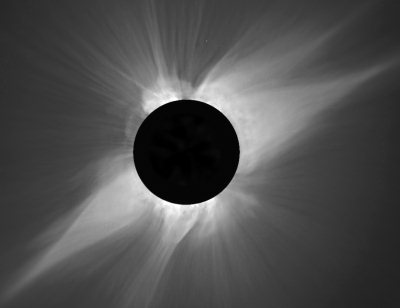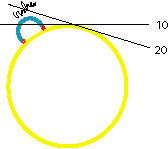Weekly Notes from the Yohkoh Soft X-Ray Telescope
(Week 39, 2002)
Science Nugget: Sept. 27, 2002
Coronal Compton scattering?
Introduction
The Yohkoh science nuggets have dealt with many aspects of solar
observations in X-rays, but have not yet discussed scattering
in the corona.
The solar corona
(the "K-corona")
is strongly polarized as a result of the what the
astronomers call "electron scattering" and the physicist knows as
Thomson
scattering in its non-relativistic treatment.
The basic idea is that a photon will strike a coronal electron, altering
(in general) its direction of motion, energy, and state of polarization
as a result of this interaction.
The result is the glorious solar corona, visible to the naked eye during
a total eclipse - or rather, the K-corona is one component, one should not
forget the
F-corona or the E-corona.

| A view of the solar corona in white light.
|
Hard X-rays
Thomson scattering does not have any wavelength dependence, although
its relativistic extension Compton scattering does.
The full physics is embodied in the
Klein
-
Nishina
cross-section which is too complicated to do more than
link
here.
So why should the very same glorious solar corona not scatter hard X-rays,
to be observed by instruments such as HXT or RHESSI?
It does, obviously enough, but hard X-rays are so "hard" to detect that
the observation of Compton-scattered coronal hard X-rays has not yet happened
(or rather, been reported).
The special circumstances that would be needed are shown in the beautiful
sketch below:
| Geometry of Compton scattering for hard X-rays in the solar corona.
We envision a flare (blue loop, red footpoints) viewed over the limb.
The lines-of-sight represent observers 10 degrees and 20 degrees around
the limb. The black squiggles represent an unrelated prominence
visible at the 20-degree occultation, which conceals the flare
loops.
|

|
The significance of this geometry is the following: our hard X-ray imaging
instruments suffer from poor image dynamic range (contrast), in the sense
that the brighter the object is, the higher the background level and its
fluctuations.
The result is fog-like.
But, for a flare hidden behind the limb, this fog would not be present
and we could see pure scattering sources, in principle.
Of course there would need to be over-dense features in the solar corona,
at sufficient altitudes (as shown), to make this happen.
Why is this interesting?
Hard X-ray polarization represents kind of a last solar observational frontier,
because it is so hard to do.
Over the years
a small community has persisted in trying to get at this
diagnostic tool, and now there is a chance with
RHESSI
in orbit.
The occulted sources could approach 100% polarization degree and thus would
make an ideal test for this capability.
More than this, even without the polarization signature, the scattered
X-rays will compete (albeit weakly, diluted by about four orders of
magnitude!) with direct hard X-ray emissions.
[Topical
index] -o- [Chronological
index]
September 27, 2002
Hugh Hudson hhudson@ssl.berkeley.edu

